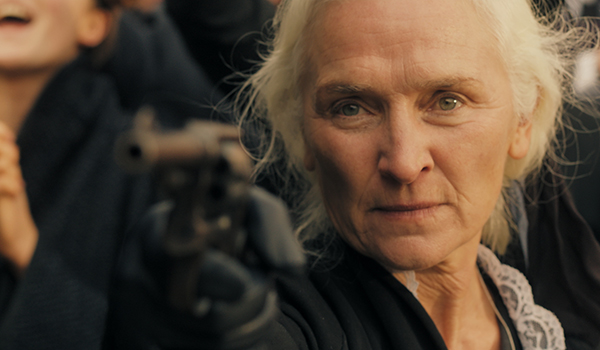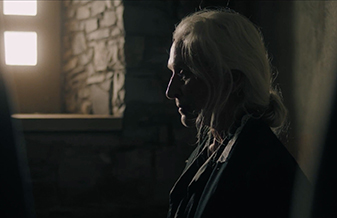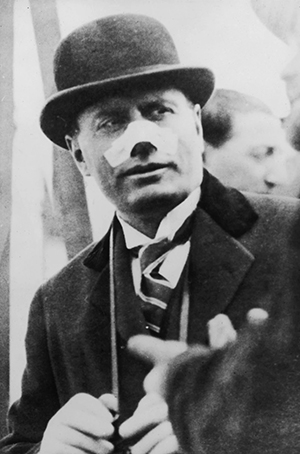VIOLET GIBSON—THE IRISH WOMAN WHO SHOT MUSSOLINI
Published in Issue 2 (March/April 2022), Reviews, Volume 30Ned Kelly Pictures
TG4, 22 Sept. 2021, 8 Jan. 2022
By Donal Fallon
In March of last year it was reported that Dublin City Council’s Commemorations Committee had agreed to the placing of a plaque on 12 Merrion Square, former home of Violet Gibson. The reported description of Gibson as a ‘committed anti-fascist’ undoubtedly raised some eyebrows.
Gibson, in the words of one historian of Mussolini’s rise to power, was ‘a half-mad mystic … merely expelled from Italy’. There ended the examination of the events of 7 April 1926, when Mussolini was fired upon in the Piazza del Campidoglio in Rome. This Irish woman who attempted to take the life of Il Duce has for almost a century been a historical curiosity and a passing footnote in the story of Italian fascism. There were other attempts on the life of Mussolini, like that by the anarchist Gino Lucetti in 1926, which have been viewed as ideologically driven and examined in considerably more detail.
Barrie Dowdall’s masterful documentary, Violet Gibson: the Irish woman who shot Mussolini, is a challenge to the perception of Gibson as an aristocrat who opened fire on Mussolini in a moment of confused madness, believing that God had told her to. While questions remain around the role of mental illness in her actions, this documentary presented Gibson’s political progression and her commitment to a wide variety of ideals, forcing us to strongly consider whether more was at play in these events than just madness.

Above: Violet Gibson (Olwen Fouéré) about to shoot fascist dictator Benito Mussolini at point-blank range in Rome’s Piazza del Campidoglio on 7 April 1926. (Ned Kelly Pictures)
Dowdall’s documentary builds on Siobhán Lynam’s 2014 radio documentary, The Irishwoman who shot Mussolini (Documentary on One, RTÉ), in which Valerie Abbey brought the voice of Gibson to life. Together with Lynam, Kevin de la Isla O’Neill and Ashley Taggart, Dowdall has written this feature-length work, which teases out some of the themes explored in that earlier work in more detail. On screen, we see Olwen Fouéré in the role of the would-be assassin, delivering it with an intensity recalling her work in bringing Beckett to stage. Much is sometimes said in silence, the vulnerabilities of Gibson made clear. It is her re-enactment that drives this documentary, though there are deep dives into archives, too, historic footage and commentary, illustrating how Italian fascism gained influence and how it later became subservient to German ambitions.
There are two chronological narratives at the heart of this documentary, both expanded on by different experts. Gearóid Barry and John Horne provide the overview of Benito Mussolini’s political journey, from a young radical who would insist on Marx being ‘the greatest of all theorists of socialism’ to a radical right-wing nationalist who proclaimed that ‘The class struggle is a vain formula’. Few political journeys have veered as radically and, while Mussolini’s attacker is the central figure of the work, Barry and Horne perfectly explain the broader context.
The other narrative, a history of the Gibson family in all its complexity, is primarily delivered by Frances Stonor Saunders, biographer of Violet. Saunders, who herself has a background in historical documentary, slowly reveals layers of the story which add to her compelling central thesis, that Gibson likely acted—at least in part—not out of madness but out of political opposition to the Italian regime. Saunders has an unrivalled awareness of Gibson’s motivations, having examined her correspondence, diaries and surviving family material. There is a certain tragedy in some of these materials, comprising letters that Gibson sent from the psychiatric hospital in which she was held to leading political figures, explaining her actions. Saunders tells us that they were never sent, and researchers like her were the first to read them.

Above: The most poignant re-enactments are those of isolation and imprisonment. Violet Gibson would spend the rest of her life in psychiatric hospital until her death in 1956. (Ned Kelly Pictures)
Turtle Bunbury positions Violet within a broader picture—drawing reference to Constance Markievicz, Maud Gonne and Anna and Fanny Parnell, all women who rejected the conventions of their privileged and Protestant backgrounds in Victorian society. The picture Bunbury paints is of a family within the upper echelon of Anglo-Irish society, and one of the most striking visual moments of the documentary is the revealing of a historic image showing a young Violet Gibson in a social gathering that includes none other than King George V himself. Violet’s father, we are told, was a ‘darling of the Conservative Party’, becoming lord chancellor of Ireland. The formative home influence was instead her brother William, who was known to his descendants as ‘mad uncle Willie’ and who not merely converted to Catholicism but fully embraced the Gaelic revival. William would join the Gaelic League and was committed to looking the part, an obituary recounting his creating ‘a mild sensation by appearing in the House of Lords in kilts and speaking in Gaelic’. His free-spirited nature and embrace of ideas beyond that expected of such an upbringing had a defining impact on Violet.
The documentary recreates the chaos and confusion of the moment Gibson fired, showing an irate crowd wrestling her to the ground, but the most poignant re-enactments are those of isolation and imprisonment. The Italian authorities were not convinced, at least initially, of her insanity. Saunders raises interesting questions around the procurement of the firearm, and Gibson’s frequent visits to the working-class districts of Rome where communist resistance to the State was strongest. Did Gibson deliberately mislead those who interviewed her, concealing real intentions and protecting a larger conspiracy?
Press coverage of Dowdall’s documentary repeatedly alluded to Violet Gibson’s story as being a ‘hidden history’ or a ‘little-known’ tale, something which has not been true for some years, with Saunders’s 2010 biography creating a new wave of interest in the story. Since then, there have been podcasts, stage adaptations and more explorations of Gibson’s life. In suggesting a plaque to her memory, it was argued that ‘it is now time to bring Violet Gibson into the public eye’, but to some extent she was already there. While her story may be familiar, there is much in this documentary that is new.
The documentary ends with the distinctive voice of Lisa O’Neill, whose song—delivered from the point of view of Gibson herself—tells us that ‘I didn’t shoot to skim the skin of his snout’. Viewers will come away from this intriguing work with their own theories on just why she did.
Donal Fallon is the author of 14 Henrietta Street: from tenement to suburbia (Dublin City Council, 2021) and the presenter of the Three Castles Burning podcast.

















